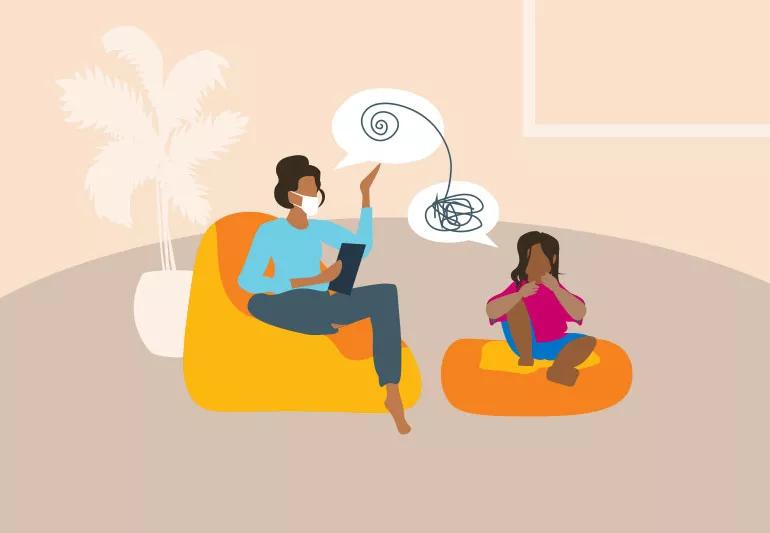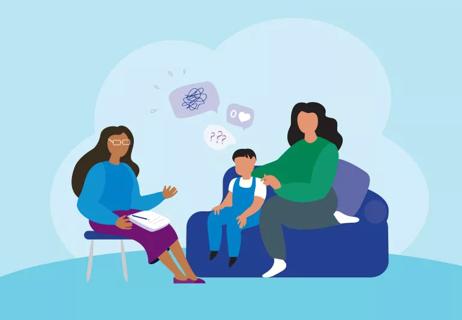Look for comfort, fit and a feeling of partnership

The bumps and growing pains of childhood and adolescence can be hard on your kid — and challenging for you to navigate as their parent. At some point, some parents may question whether they should seek help for their child.
Advertisement
Cleveland Clinic is a non-profit academic medical center. Advertising on our site helps support our mission. We do not endorse non-Cleveland Clinic products or services. Policy
“Every child is different,” says pediatric psychologist Amy Lee, PhD. “A therapist can help you understand what behaviors are healthy and how to cope as new concerns arise. They can also teach you tools and strategies to help your child. For many parents and children, therapy is reassuring and empowering.”
Mental health concerns are common in children and teens. Even before COVID-19, a national study found that nearly 1 in 5 children had a mental health issue such as:
“Recent data has revealed that more kids and teens are dealing with anxiety, depression and difficulty coping with life’s daily challenges than ever,” says Dr. Lee.
“Not every child experiencing periods of anxiety, stress or sadness needs therapy or mental health treatment. Every kid does need to be validated and understood, so if your child is struggling, try listening and validating their feelings. Sometimes, they just need to be heard.”
If a problem persists with coping and affects the behavior of your child and negatively impacts your family, it’s time to get help. You may feel that their anxieties and fears have gone beyond the typical worries of childhood. Some signs your child may need a therapist include:
Advertisement
“You know your child best,” says Dr. Lee. “If something seems off, it’s a good idea to have it checked out. A good place to start is by talking to your child and also their pediatrician or primary healthcare provider. Today’s primary healthcare providers are ready with suggestions and information on how to find the right kind of help.”
Child therapists have specialized training in child and adolescent development, as well as with issues young people face in everyday life. They study the typical stages children go through so they can identify when a child is experiencing something difficult or concerning.
“Children can’t put their thoughts and feelings into words like adults, but they do often know quite a lot about what is difficult for them or how they are feeling,” notes Dr. Lee.
Some child therapists have specialized areas of practice. Depending on your child’s condition, you may look for someone with expertise with specific:
If you’re not sure where to start, talk to your child’s primary healthcare provider for suggestions and choose a therapist with an appropriate range of experience. They can get you started and refer you to a specialist if needed.
Make sure the therapist has the right qualifications. Education level and licensure determine the types of services a therapist can provide and if they can prescribe medication. Types of therapists include:
Advertisement
Finding the right type of therapy starts with a comprehensive evaluation. Your therapist will meet with you and your child — together and separately — to get a clear picture of the situation, including taking a record of any family history, discussing problems and reviewing a treatment plan.
“I work closely with parents and kids to identify their concerns, whether these concerns are related to temperament, development or life stressors, and to provide a clear plan regarding next steps,” says Dr. Lee.
During an evaluation, the therapist looks at your child’s:
An evaluation also includes questions for you about what strategies you’ve tried, what helps and where you get stuck.
After reviewing all this information, the therapist establishes a diagnosis and works with you to develop a plan. The next steps could include setting some goals and starting therapy. Sometimes, a child needs more in-depth assessments or a referral to a psychiatrist for a medication evaluation.
Advertisement
There are many types of child therapy. The type your child receives depends on your child’s age and diagnosis.
“I think of therapy like building a toolbox,” explains Dr. Lee. “You don’t need every tool every day. But by having them, you’re prepared. In therapy, we try to build resiliency by identifying gaps in the toolbox and filling them in.”
Your child’s therapist might focus on strategies to:
Some common types of counseling child therapists use include:
Cognitive behavioral therapy (CBT) is a type of talk therapy. It explores the relationships between your thoughts, feelings and actions. CBT is a common treatment for anxiety, depression and other emotional issues. Children can usually start CBT around age 9 or 10.
CBT helps replace negative thoughts with more positive ways of thinking, which helps improve feelings and behaviors.
Dialectical behavioral therapy (DBT) helps people learn strategies to manage their emotions better. It focuses on identifying triggers and finding different ways to respond in the moment. DBT is a common therapy for teens.
Advertisement
Behavioral therapy helps parents manage children’s actions by reinforcing positive behaviors and reducing negative ones. It may involve the use of checklists or rewards.
Behavioral therapy can help children develop better routines and improve self-control. Children with ADHD often respond well to behavioral therapy.
Therapists observe how younger children play to better understand their feelings. Play therapy can show a lot about the difficulties and conflicts children are experiencing in real life. Even for older kids, imaginary play often reflects what’s going on in their world. Therapists also use play therapy to help children practice new skills.
Applied behavior analysis (ABA) is therapy for children with autism spectrum disorder. It involves reinforcing appropriate responses from your child in the moment to make things easier for them and help them behave.
If your child has autism spectrum disorder, you may want to look for a therapist who specializes in ABA.
Occupational therapy (OT) helps children practice specific skills, such as getting dressed, writing and playing. It’s also beneficial for children with sensory sensitivities, such as to textures or loud noises.
Occupational therapists provide OT. Mental health counselors often refer children to OT as part of their treatment plan.
Child therapy can occur at the group, family and individual levels. What’s best for your child depends on their unique situation.
In group therapy, children meet with others going through similar experiences. Older children and teens often find group therapy provides validation and helps them understand they’re not alone. They can also practice and learn new skills during group sessions.
Group therapy can be effective for children with anxiety, depression and eating disorders. If you’re waiting to see a psychologist, a group may be a good option to start addressing the area of concern.
Family therapy focuses on improving communication, reducing conflicts and understanding one another better. It’s often a good avenue for examining the dynamics underlying the child’s difficulties.
“In family therapy, everyone can share their feelings and concerns,” explains Dr. Lee. “It’s a very tailored approach to a specific set of goals, such as getting everyone to agree on a different way to move forward. It’s helpful to do that with multiple people at once.”
Child therapy isn’t just for your child. Parents and caregivers often have a role to play as part of the therapy team.
“I work very closely with parents,” says Dr. Lee. “Kids want to do the right thing most of the time. Parents can help them understand what the right thing is and how to get there.”
Your child’s therapist may coach you to help you:
“Sometimes, it’s a matter of seeing your child through a different lens. Changing your own reaction to your child’s behavior can have a profound impact,” Dr. Lee encourages.
Child therapists often work directly with children. “I always start with the parents,” she says. “But once I understand the concerns and the parents have some trust, I frequently meet with the child individually. I may want to get a sense of how the child behaves when the parent is not there. It’s also important for me to understand the child’s point of view.”
The first step in getting help for your child is learning if there’s a problem.
“Pediatricians are an excellent resource,” says Dr. Lee. “They can rule out anything medical that might be causing the concern. They can also provide reassurance, strategies or a referral to a mental health provider.”
Other resources to consider include your:
“Ultimately, finding the right therapist is about comfort and fit,” says Dr. Lee. “You should always feel like you’re collaborating as a team.”
Helping your child through a mental health issue can be stressful for parents. Dr. Lee often recommends parents get their own counselor, too.
“When parents manage their own stress, they can respond better to their child.”
At the end of the day, it’s OK to ask for help and get your child the help they need before things get worse. If you or your child is concerned for their safety, 988 is also available as a 24/7 mental health crisis lifeline for anyone who needs mental health support.
Learn more about our editorial process.
Advertisement

Be involved in your kid’s care, but be mindful of boundaries

Research types, find a therapist who fits you and remember — therapy isn’t a sign of weakness

And a few reasons why your BFF shouldn’t be your therapist

The short answer from a psychologist

Getting therapy isn't a sign of weakness

The same things you do to treat sore muscles after exercise can help treat soreness after a massage

Relationship guidance from a professional can help with communication, intimacy and trust

Type 2 diabetes isn’t inevitable with these dietary changes

Applying a hot or cold compress can help with pain